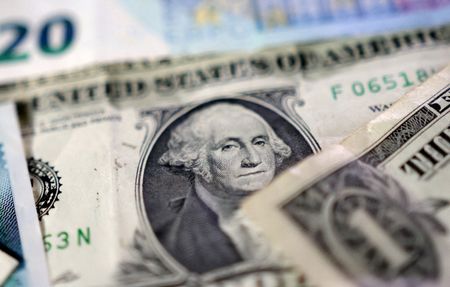By Rae Wee and Amanda Cooper
SINGAPORE/LONDON (Reuters) -The dollar stuck to its recent trading range on Wednesday, with investors choosing to stay on the sidelines after another round of weak U.S. data and as President Donald Trump prepared to fill a coming vacancy on the Federal Reserve’s Board of Governors.
Trump said on Tuesday he will decide on a nominee to replace outgoing Fed Governor Adriana Kugler by the end of the week and had separately narrowed the possible replacements for Fed Chair Jerome Powell to a short list of four.
Data on the same day showed the U.S. services sector activity unexpectedly flatlined in July while input costs climbed by the most in nearly three years, underscoring the hit from Trump’s tariffs on the economy, which have also begun to bite corporate earnings.
Still, traders were hesitant to take on fresh positions ahead of the Fed developments. Concerns are mounting that partisan loyalty could invade the staid world of central bank policy.
The dollar was last flat against the yen at 147.55, while the euro edged up 0.3% to $1.16065. Sterling reversed earlier losses to trade up 0.1% at $1.3324.
“Trump’s open attacks on the Bureau of Labor Statistics over payroll revisions have not had much market impact, but it will be interesting to see whether the selected Fed chair candidate echoes that narrative. If so, it could ignite fears of a disconnect between Fed policy and official data – a scenario we see as decidedly dollar-negative,” ING strategist Francesco Pesole said in a note.
TREASURY YIELDS RISE
While moves in the dollar have been more subdued this week, the currency has yet to recover from its steep losses on Friday, when it clocked its largest one-day percentage fall in nearly four months following an alarming jobs report.
Trump fired BLS commissioner Erika McEntarfer last week, after the July employment report.
Against a basket of currencies, the dollar dipped 0.2% to 98.547, some way off Friday’s peak of 100.25 hit before the nonfarm payrolls figures.
Traders continue to price in a 91% chance of a Fed rate cut in September, with about 58 basis points worth of easing expected by the year-end.
But data such as Tuesday’s services ISM report underscore the fine line the Fed has to tread, as policymakers weigh rising price pressures from Trump’s tariffs against signs of a weakening U.S. economy.
“The services ISM has obviously got that kind of stagflationary whiff about it … that’s obviously a bit of a two-edged sword in terms of what does that mean for policy,” said Ray Attrill, head of FX research at National Australia Bank.
“At the moment, I think we’re sort of the view that maybe there’s a bit too much confidence in the market about the certainty of a September move.”
U.S. Treasury yields rose, leaving the 10-year note up 4.2 basis points on the day at 4.238% and two-year notes up 2 bps at 3.74%, after a $58 billion auction of 3-year notes, which was seen as somewhat soft by analysts, with demand equivalent to 2.53 times the notes on sale.
More supply hits the market this week with $42 billion in 10-year notes on Wednesday and $25 billion in 30-year bonds on Thursday.
Among other currencies, the Australian and New Zealand dollars both rose 0.6% to $0.6506 and $0.5933, respectively.
(Additional reporting by Rae Wee and Gregor Stuart Hunter in Singapore; Editing by Sam Holmes, Lincoln Feast, Kim Coghill and Alison Williams)










